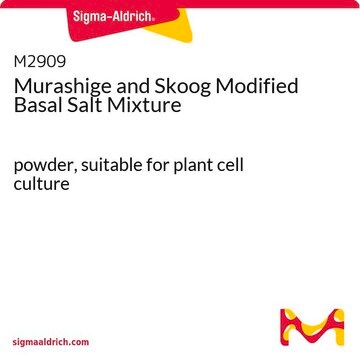D5417
Acide 3,6-Dichloro-2-méthoxybenzoique (Dicamba)
suitable for plant cell culture, BioReagent
Synonyme(s) :
Acide 3,6-dichloro-o-anisique
About This Item
Produits recommandés
Gamme de produits
BioReagent
Forme
powder
Technique(s)
cell culture | plant: suitable
Pf
112-116 °C (lit.)
Application(s)
agriculture
Température de stockage
2-8°C
Chaîne SMILES
COc1c(Cl)ccc(Cl)c1C(O)=O
InChI
1S/C8H6Cl2O3/c1-13-7-5(10)3-2-4(9)6(7)8(11)12/h2-3H,1H3,(H,11,12)
Clé InChI
IWEDIXLBFLAXBO-UHFFFAOYSA-N
Vous recherchez des produits similaires ? Visite Guide de comparaison des produits
Description générale
Application
- as an auxin to maintain wheat embryos post pollination
- as a Murashige and Skoog (MS) medium supplement to culture embryos
- as an auxin in induction medium to induce somatic embryogenesis in barely tissue culture
Actions biochimiques/physiologiques
Conditionnement
Notes préparatoires
Mention d'avertissement
Danger
Mentions de danger
Conseils de prudence
Classification des risques
Acute Tox. 4 Oral - Aquatic Chronic 3 - Eye Dam. 1
Code de la classe de stockage
11 - Combustible Solids
Classe de danger pour l'eau (WGK)
WGK 2
Point d'éclair (°F)
Not applicable
Point d'éclair (°C)
Not applicable
Équipement de protection individuelle
dust mask type N95 (US), Eyeshields, Gloves
Certificats d'analyse (COA)
Recherchez un Certificats d'analyse (COA) en saisissant le numéro de lot du produit. Les numéros de lot figurent sur l'étiquette du produit après les mots "Lot" ou "Batch".
Déjà en possession de ce produit ?
Retrouvez la documentation relative aux produits que vous avez récemment achetés dans la Bibliothèque de documents.
Les clients ont également consulté
Notre équipe de scientifiques dispose d'une expérience dans tous les secteurs de la recherche, notamment en sciences de la vie, science des matériaux, synthèse chimique, chromatographie, analyse et dans de nombreux autres domaines..
Contacter notre Service technique












